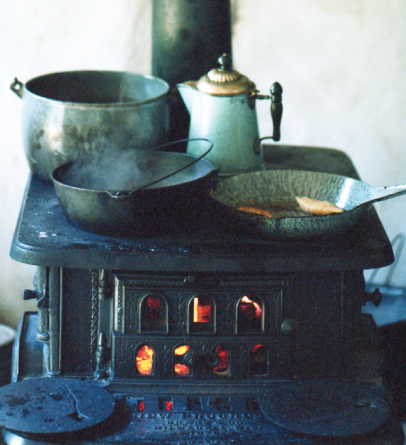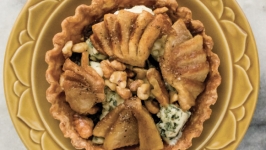Food Traditions Kept Alive in Old World Wisconsin
There are pies and there are pies at Old World Wisconsin (OWW). Follow your nose to the trim Schulz farm where the perfume of a freshly baked zwiebelkuchen, or traditional German onion pie, wafts out past the neatly tended vegetable garden.
Thus it is at OWW, where you can roam more than 500 acres of fields and woods, poking through historical Wisconsin homesteads to watch knowledgeable interpreters turning steamed onions, diced bacon, cream and caraway seeds into a hearty lunch pie fit for….well…a husky Pomeranian farmer and his family. Keep walking (or take the free trolley) to the Schottler homestead where a loaf of rye bread, from grain just harvested on-site, is cooling. Continue your culinary adventure back into time by pausing at the Koepsell farm to see the sweet delight of freshly-made currant sauce lining the shelves. A crock of curdling cottage cheese lolls on a nearby table, soon to be ready for tasting.
Wait, there’s more. Mrs. Kruza (actually all these characters are played by OWW staffers) has just finished preparing kraut pierogi in her tidy kitchen, creating a marvelously versatile Polish dumpling made of unleavened dough. This delight is first boiled, then baked or fried after being stuffed with potato filling, fruit, ground meat, sauerkraut or cheese. True to Wisconsin tradition, oodles of butter and onions are added for an extra caloric boost.
Accompanied by the dazzle of flickering bluebirds, you eventually arrive at the Hafford House to see Irish soda bread and sugar cookies laid out in delightfully decadent style, prepared just as homeowner/housewife Mary Hafford did in 1885. Be sure to stroll across the dirt road to the Four-Mile Inn, near where Sam the Percheron dozes in the shade. Inside the old stagecoach stop and boarding house, you’ll learn how to jar juneberry jelly. Screw-on caps for jars were just coming into vogue then, demonstrating how industrialization was providing newfangled inroads into daily life.
As a time-traveling visitor to OWW, you need to keep moving to take it all in. The Wisconsin State Historical Society site near Eagle is among the state’s favorite historic locales. The living museum features more than 60 buildings gathered from around Wisconsin to form a crossroads village and a series of ethnic farms. The complex makes up one of the world’s largest facilities dedicated to the history of rural life, opening in 1976. Each building was painstakingly dismantled, shipped to OWW and then rebuilt and opened for exploring. All this is only about a hour’s drive west of Milwaukee, tucked into the flower-bedecked Kettle Moraine countryside.
A retired medical technician and dedicated master gardener, Alice Lundstrom tends to the small beds of flowers and vegetables at the Schulz farm, dating to the 1860s. As Lundstrom leads visitors around the property, Alpine strawberries burst in crimson explosions from their hiding places, while towering marshmallow plants nod in the lazy breeze. The latter’s roots were once cooked and blended with honey to make a concoction that treated sore throats. But you won’t find tomatoes in the garden here; folks back then were still getting used to the notion that they weren’t poisonous.
Hanging in the open chimney above the fireplace in the house’s “black kitchen,” called that because of the soot coating the bricks, a ham from one of OWW’s own hogs is receiving a good smoking. The great slab of prepared pork will eventually be served to staff, who are able to enjoy the fruits of their farm labor. “I love the challenge of making our threshing dinners and our harvest dinners,” says Karl Kaphengst, OWW food and craft coordinator. “In both cases, we are serving a period ethnic dinner to 30 to 40 volunteers and staff. Having all the food done and on the table when the workers come in from the field is like winning the Super Bowl.”
The museum also lets young guests sample what kids ate in the “good old days” during its annual Farm-to-Table camp in July, which is usually sold out. The youngsters gather seasonal produce from one or another of the 12 historical gardens on the grounds. They learn how a wood-burning stove works, sip freshly-brewed mint tea and enjoy a lunch that would do justice to Laura Ingalls Wilder’s tales about growing up in pioneer days. (Wilder was born and spent part of her childhood near Pepin, WI in the late 1860s, forming the basis for her children’s books, Little House on the Prairie and Little House in the Big Woods.)
For another OWW experience, kids can participate in “The World of Little House” each summer with games of the time, watching threshing and entering look-alike contests featuring characters from Wilder’s stories. Learning to be authentic foodies, they’ll knead bread dough in the Schottler summer kitchen and churn and wash butter at the Koepsell farm, where sheep graze in a nearby paddock and Rhode Island Red chickens peck away amid the vegetables.
During the OWW’s summertime’s Civil War encampments, children learn that not all foods are gourmet. They discover how to boil salt pork, dish out beans and chaw on hardtack, a simple biscuit made from flour, water and salt. Allegedly, these “edible rocks” could last up to 50 years if kept dry. Take that, Twinkies!
All the foods made at OWW have been carefully researched, with ingredients and prep practices gleaned from settlers’ notes, publications from the appropriate eras and other historical resources.
When researching recipes for any exhibit at OWW, food coordinator Kaphengst considers the time period of the restoration, the family’s exposure to American ideas and the length of time they have been in America. “One other consideration is literacy. Is the immigrant able to read and is she able to read in English? This can really define the limits of a food program for an exhibit,” Kaphengst explains. In addition, he says, “It is important to have recipes for the seasonal foods that we have available from our gardens and farms. For example, our visitors will not see potatoes being used in the summer because they aren’t in season.”
According to Marcia Carmichael, OWW’s historical gardener, the state’s earliest pioneers hunted, fished and foraged. As they settled into their new homes, they planted gardens from seeds carefully carried from their overseas homelands or secured from traveling salesmen and even nurseries. “The immigrants found comfort in growing familiar plants and added favorites when they could,” says Carmichael, who operated her own greenhouses and herb business before joining OWW.
For her work in organizing the museum gardens, she has received honors from the Wisconsin Garden Club Federation, the Herb Society of America, the International Herb Association and other organizations.
Carmichael is also the award-winning author of Putting Down Roots: Gardening Insights from Wisconsin’s Early Settlers, featuring OWW’s gardens and recipes (Wisconsin Historical Society Press, 2011, $24.95).
You may wish to take a regularly scheduled Heirloom Garden Tour that features various ethnic homesites, including the Sanford house in the Yankee area, the Schulz farm in the German section and the Ketola and Rankinen gardens in the Finnish complex.
Carmichael tells how pioneer women gave birth; churned butter; made cheese, wine and cider; cooked and baked; brewed ale; preserved food; sheared sheep and wove wool; produced candles; did the laundry; and cleaned house. The equally hard-working husband spent his time tending to the livestock, repairing equipment and laboring in the fields, using oxen to pull plows and threshing machines.
“The word ‘leisure’ was not part of the vocabulary,” she says.
EATING AT OLD WORLD
Old World Wisconsin celebrates the harvest season with special programs Thursdays through Sundays, September 7 through October 13 during “Autumn on the Farms.” Guests can pitch in to help out “farmers” and “villagers” bring in the crops, stock the larder and put up the produce for winter.
Extend your experience with a Rousing with the Roosters breakfast Sept. 7 and 21 by working in the Schottler bakehouse. You can help prepare a sunrise meal the same way immigrant farmers did, feasting on creamed bratwurst, scrambled eggs, seasonal vegetables, biscuits, corn bread, velvet cake with fruit sauce, milk and coffee. (Gluten-free options are available.)
Halloween Dinner Theater shows are held weekends in October, featuring a themed harvest meal and an original production of “Wake Not the Dead.” The museum’s Holiday Dinner Theater in the Clausing Barn loft in November and December showcases a traditional holiday dinner and the Christmas drama, “Little Women,” in the Caldwell Farmer’s Club Hall.
The 30th annual ethnic holiday dinner, with Yankee, German, Irish and Scandinavian foods, is set for Dec. 7 and 8 and Dec. 14 and 15. A breakfast buffet with Father Christmas is scheduled for Dec. 21 and 22.
For more information on tours, hours and directions visit the Old World Wisconsin website.
Be sure to check out Edible Milwaukee to see Joe and Rob’s photo-essay about their day at Old World Wisconsin, and catch up on all the savory snapshots!






